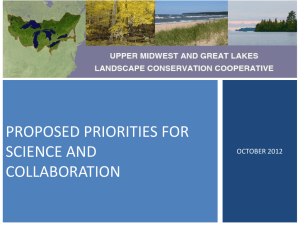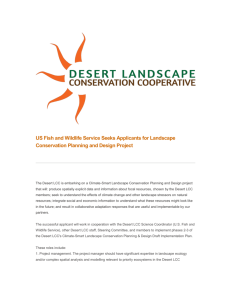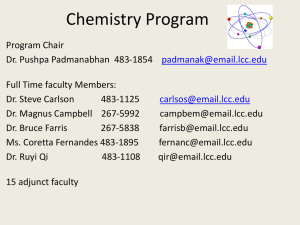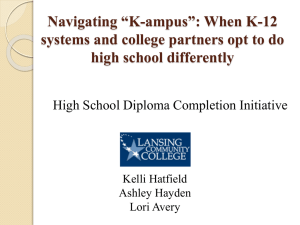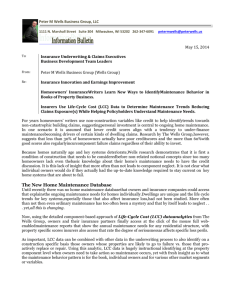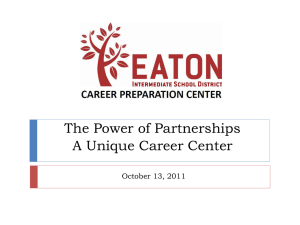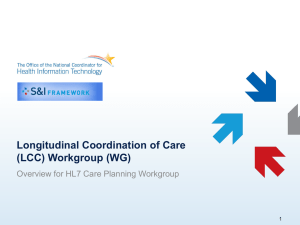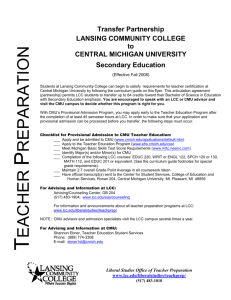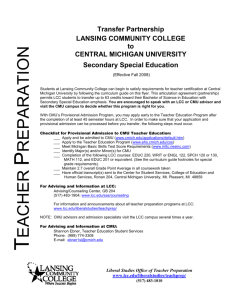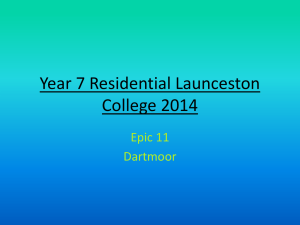An “EPIC”
advertisement
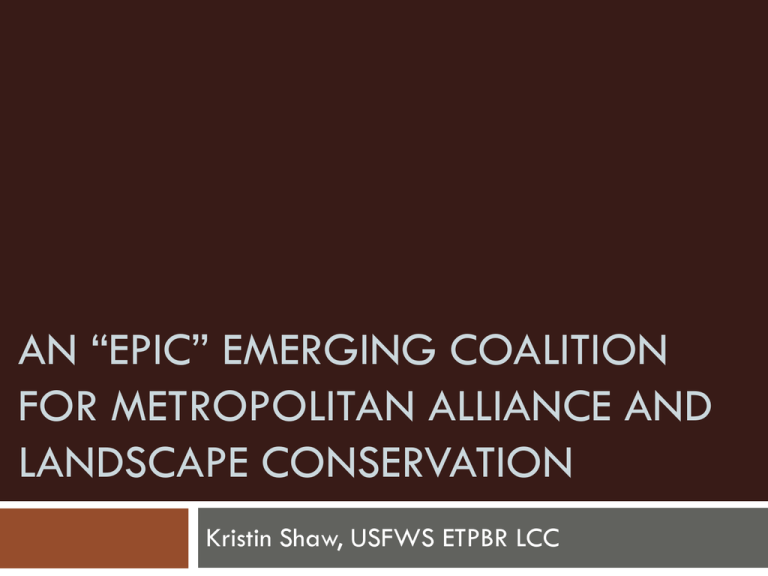
AN “EPIC” EMERGING COALITION FOR METROPOLITAN ALLIANCE AND LANDSCAPE CONSERVATION Kristin Shaw, USFWS ETPBR LCC Roadmap of the Presentation Introduction to Landscape Conservation Cooperatives and the ETPBR LCC Midwest Urban Conservation Workshop Overview and Outcomes Creation of Ecological Places in Cities (EPIC) Introduction to Landscape Conservation Cooperatives The story of the ETPBR LCC ETPBR LCC STRUCTURE Management community • • • • • • Conservation agencies Private landowners Business community NGOs with on-the-ground interests Communicate priority Science Needs from the field Test research outcomes in management context Steering Committee • • • • Strategic direction Organizational oversight Funding decisions Implementation authority LCC Staff • • • Organizational development & operations Communication across groups & outreach Share resources & concepts through FWS Region 3 Science Advisory Team & National LCC Network Technical Advisory Groups (TAGs) • • Research Community • • • • • • Universities & Business R&D Agency & NGO research scientists Forecast future challenges Bring cutting edge ideas& tools Conduct applied research Describe management implications of research outcomes • • • • • • • Refine strategic plan; develop science agenda Propose targeted RFPs or project scopes of work; proposal review Proposed ETPBR LCC TAGs Prairie Restoration (share with UMGL & PPP) River Restoration (share with PPP) Agroecology (share with PPP and GCPO LCC) Urban Watersheds (share with UMGL) Regional Conservation Design (shared with UMGL & PPP) – delivery through SWAPs, NGO plans, etc. Information & Technology Transfer P-BRAT: Prairie-Big Rivers Advisory Team (staff liaisons to US FWS programs) Process & Tasks for Technical Advisory Groups (TAGs) 1) Clarify the Problem Statement (decision context) 2) Set Fundamental Objectives (outcomes) 3) Impact Models relate objectives to decisions (tradeoffs between management actions) 4) Identify stakeholders & decision-makers 5) Identify key uncertainties (Science Needs) – gaps in knowledge and resources 6) Recommend criteria for prioritizing needs 7) Guidance for project review & evaluation 8) Develop portfolio of desired science projects for RFP Focal Area 4. Urban Watersheds Means Objectives Build on re-orientation of cities to their waterfronts to promote local wildlife habitat and outdoor recreation. Utilize river systems as the foundation for incorporating functional wildlife corridors in green infrastructure plans. Design urban, suburban and small estate developments to accommodate conservation of prairie and river systems in urban green spaces. Enhance viability of small towns in rural areas by attracting tourists and businesses to recreational activities at local prairie and river restoration sites. The Midwest Urban Conservation Workshop Midwest Urban Conservation Workshop Overview • • • 46 participants States Represented: Iowa, Illinois, Indiana, Missouri, Minnesota Entities represented: City, State, and Federal Employees, Nonprofits, Private Sector Workshop Planning Process Urban TAG Planning Committee Selection Topic Selections Speakers? Who to invite? Collective Impact Brainstorming day Goals of the Workshop Kids playing outdoors near St. Louis, Missouri. Photo by Ashley Spratt/USFWS Understand the status of Urban Conservation Establish science needs and introduction to new topics Understand the management practices being used. Establish avenues for collaboration. Create an opportunity for networking and relationship building Create a collective impact through establishment of working groups and cooperatives. Summary of Presentations April 29th: • Ecological Homogenization • Green Infrastructure • Large Landscape Conservation • Social Hour- Poster Presentations April 30th: • Biophilic Cities • Collective Impact • Establishing Collaboration • Community Outreach • Public Keynote May 1st: • Creation of Collective Impact Ecological Places in Cities -- EPIC Picture: Leiden, The Netherlands Street divided by natural vegetation. -Kristin Shaw Collective Impact Framework of EPIC 1. Common Agenda 2. Shared Measurement Based on programs that participants are interested in 4. Continuous Communication To be determined as thematic areas are established 3. Mutually Reinforcing Activities We are a network that reconnects (integrates) people and nature in Midwestern cities, their surrounding working landscapes, and natural areas. Provided by staff of the LCC and Collaborative Working Space Website 5. Backbone Support ETPBR LCC & UMGL LCC Backbone Support and Common Agenda Backbone Support ETPBR LCC/ UMGL LCC Communication Funding Network Capabilities/Tools Common Agenda Creation during Workshop Vision: We are a network that reconnects (integrates) people and nature in Midwestern cities, their surrounding working landscapes, and natural areas. Process of Crafting/ Refining Functions of EPIC Education and train the trainer Wildlife conservation Habitat restoration Community revitalization Landscape planning Encompass Research city plans into the landscape scale Themes Who is involved? Cities Not for Profit Federal Agencies ETPBR LCC & UMGL LCC Universities States EPIC Next Steps Analysis of available resources from EPIC Members (area of expertise, projects, etc.) Where they fit in to topics Based on tools available and interests of EPIC Membersnarrow down themes Based on themes target core team members for creation of mission, goals, and solidifying vision Outreach to subregional hubs - subject to change based on how we divide the region (HUCs, migratory bird, population) Strategic plannning workshop - lead to 5 year strategic plan and guidance on the creation of tools Interested in being a part of the process? Contact Kristin Shaw, Urban Watersheds TAG Coordinator ETPBR LCC Email: Kristin_Shaw@fws.gov 812-334-4261 x1209 (o) 712-294-4585 (c) http://exploreportlandnature.wordpress.com/2012/02/23/cartoons-about-children-and-nature/ QUESTIONS?
